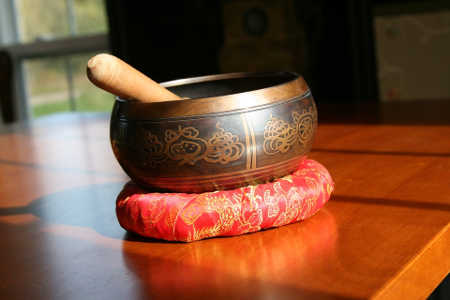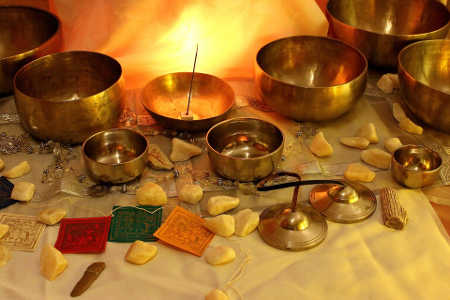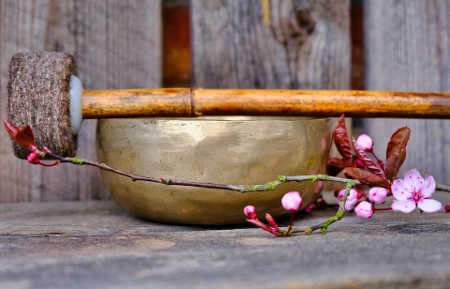
You may have seen a singing bowl on a more spiritually-inclined friend’s table or altar, along with other things like salt lamps or rudraksha beads. But what are these bowls used for?
What are singing bowls? Tibetan singing bowls have a long history of use to assist with meditation, chanting, yoga, and relaxation. They are essentially inverted bells. You play a singing bowl by striking or running a mallet along their rim.
In this article, I’ll explain what singing bowls are, what they’re made of, and other details. I’ll help you figure out how to pick the right singing bowl for you. Then I’ll go over how to play it, and what some of the purported benefits of singing bowls are.
What Are Singing Bowls?
You can think of singing bowls sort of like an upside-down bell. They rest on a surface with a bowl-shaped opening at the top. They produce a sound similar to a bell, but typically more as a long, continuous note.
Singing bowls come in a huge variety of sizes. From just a few inches to several feet in diameter.
Some singing bowls are played by striking them with a soft mallet. But it’s more common to use a wooden mallet which is rotated along the outside of the singing bowl’s rim to produce a long, continuous sound.
Singing bowls are used alongside chanting, meditation, and relaxation. As well as simply background ambiance music for spas and other locations.
What Are Singing Bowls Made From?
Traditionally, singing bowls are made of all different kinds of metal alloys. Commonly used are gold, silver, copper, tin, iron, brass, or lead.
Choosing The Right Singing Bowl For You

Picking a singing bowl is deeply personal. There are a lot of different bowl options to choose from in terms of size, color, shape, tone, and other characteristics.
I would recommend choosing a singing bowl that appeals to you based on appearance, and more importantly, sound. If you have multiple designs to choose from, feel free to experiment and get a feel for each of them. Some tones may not resonate with you at all, while others may feel like they vibrate more on your own frequency.
So I would focus on sound first, and then decide secondarily based on appearance. You may want a bright shiny copper singing bowl. Or you might be looking for something that looks more aged and antique with a patina finish. Some bowls may also have various markings or inscriptions on them as well. Some may include images of the Buddha, the symbol for Om, and other designs.
If I had to pick one singing bowl to recommend, I’d go with one of these (Amazon link.) The seller provides the option to by a 4, 5, or 6 inch brass bowl. Each comes with a wooden mallet and a mallet to rest it on. Plus a free set of Tibetan prayer flags and a piece of wall art featuring a quote from the Dalai Lama. It’s perfect either for yourself or as a gift for the meditation practitioner or spiritual person in your life. These bowls produce deep, rich tones and are hand-hammered by real Tibetans, not just made in a factory like so many other bowls on the market.
How To Play A Tibetan Singing Bowl
Singing bowls may seem similar to gongs. But musically, they are categorized as bells. That’s because gongs typically vibrate toward the center of their structure, whereas bells have the most vibration around their rims.
The simplest way to play a singing bowl is to lightly strike it with a mallet. This will emit a bell-like ring that will fill the air for several seconds.
A more advanced way to play a singing bowl is to use a wooden mallet (also called a puja.) When a singing bowl is played this way, the mallet is slowly slid around the outside of the rim to create a constant vibration. If you’ve ever seen someone produce a note by rubbing the rim of a wine glass, a singing bell operates on a similar principle when played this way.
You can manipulate the sound to be quieter or louder, depending on how fast you run the mallet around the rim and how much pressure you apply.
You can also slightly alter the pitch of your singing bowl by filling it with a little bit of water. Start by filling it less than a quarter of the way full as a general rule. If you hit just the right speed, you might get tiny standing waves that develop in the bowl because of the frequency. The sound produced by a singing bowl with water in it is said to sound a bit like dolphins singing.
If you have trouble playing a singing bowl by using a mallet, just imagine that you’re slowly stirring a big pot of soup! Hold your mallet straight up and down and slowly move it around the rim. The movement should come from your elbow or entire arm, not just your wrist.
Over time your wooden mallet will likely start to develop some grooves where you rub it along the edge of the bowl. This is called “breaking in” the mallet and can actually produce a better sound with time. The tiny grooves in the mallet will allow it to better grip the bowl and produce a more pure tone.
The Benefits of Singing Bowls
Singing bowls are reported to have numerous benefits. Although very few scientific studies have ever been conducted to verify these claims.
Here are some claimed benefits of singing bowls. Note that I’m not claiming that singing bowls are effective for these purposes, but simply relaying that this is what they are used for by many people.

For Healing
There are those that believe singing bowls can help promote healing. They certainly help with relaxation by assisting with deep breathing or meditation. But there are other more specific benefits that are reported such as pain relief as well.
Some users go as far as to say that singing bowls can have an effect on the cells of the body to balance the body’s energy system or boost the immune system. Of course there is no scientific evidence to back this up, and you should still consult your doctor if anything is wrong.
One study did find that singing bowls had a positive effect on blood flow and circulation. Although this could just be an effect of other relaxation techniques that were done alongside the use of the singing bowls.
For Balancing The Chakras
In some schools of Buddhism and Hinduism, it’s believed that chakras in the body can become blocked or unbalanced, which can lead to all kinds of problems with your health and other areas of your life. Different tones of singing bowls are associated with being helpful to open various chakras in the body, to help balance and adjust these energy centers in the body.
For Producing Deep Relaxation
Singing bowls can help to reduce anxiety and stress, and put people in a more relaxed state. The calming sound combined with deep breathing can help release tension in the body, and gives many people a sense of calm.
Helps You To Focus
Like other forms of meditation or concentration, using singing bowls can help your brain to operate on different brainwave frequencies than in your daily life. Some of these are better for concentration and focus, and the benefit often persists for a while you finish using your singing bowl. So it’s a great way to start your day off on the right foot.
Conclusion
Singing bowls can be a great addition to your spiritual practices. Whether you use them for meditation, yoga, as part of specific rituals, or just as a way to relax after a long day.
Singing bowls come in a wide variety of materials. When choosing one, pick what feels like it resonates with you, both in terms of appearance and musical tone.
Playing a singing bowl is quite easy and only takes a few minutes to pick up. You can play it by softly hitting the edge with a mallet. Or you can produce a more consistent note by slowly running the mallet along the outside of the bowl.
Even if you don’t plan on buying a singing bowl any time soon, I’d recommend finding a shop in your area that has them and giving one a try. It can be a really fun experience!